7.4 /10 1 Votes
Original language(s) English Final episode date September 1985 | 7.4/10 IMDb First episode date April 1984 Number of episodes 14 (including the pilot) | |||||||||||||||||||||||||||||||||
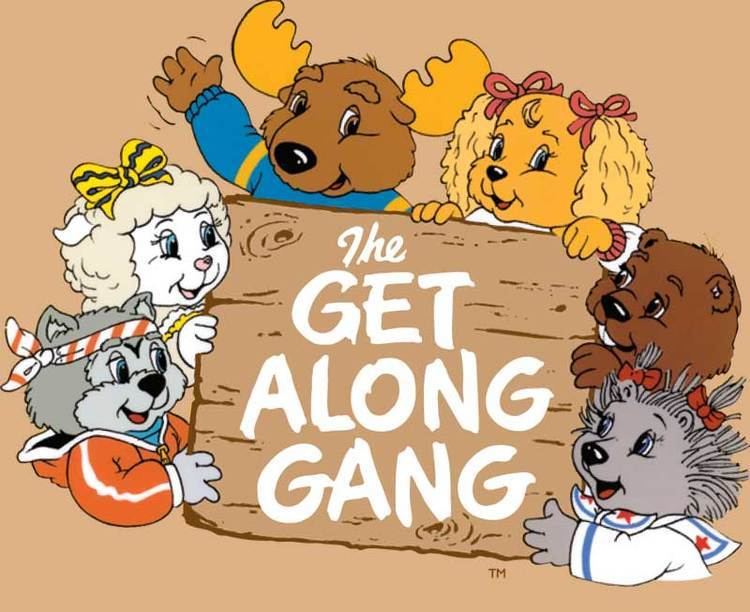 | ||||||||||||||||||||||||||||||||||
Created by Those Characters from Cleveland Starring Sparky MarcusBettina BushSherry LynnRobbie LeeGeorgi IreneScott MenvilleTimothy GibbsNicky KattFrank WelkerDon MessickChuck McCann Country of origin FranceUnited StatesCanada (pilot episode) No. of episodes 14 (including the pilot) Cast Similar Wildfire, The Wuzzles, Kissyfur, Muppet Babies, Heathcliff & the Catillac Cats | ||||||||||||||||||||||||||||||||||
The get along gang nelvana 1985
The Get Along Gang are characters created in 1983 by American Greetings' toy design and licensing division, "Those Characters from Cleveland" (now American Greetings Properties), for a series of greeting cards. The Get Along Gang are a group of twelve (and later, fourteen) pre-adolescent anthropomorphic animal characters in the fictional town of Green Meadow, who form a club that meets in an abandoned caboose and who have various adventures whose upbeat stories intended to show the importance of teamwork and friendship. The success of the greeting card line led to a Saturday morning television series, which aired on CBS for 13 episodes in the 1984-1985 season, with reruns showing from January until June 1986.
Contents
- The get along gang nelvana 1985
- Gag caboose on the loose
- Characters
- TV series
- Voices
- Other merchandise
- Reception and criticism
- Decline and attempted revival
- Home entertainment releases
- In other countries
- Nelvana
- References
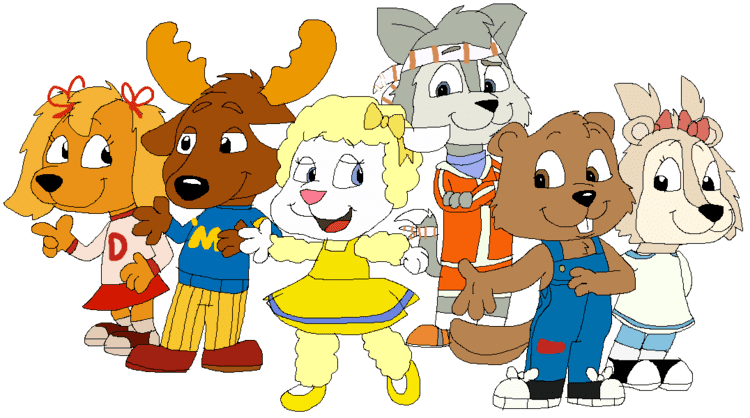
Gag caboose on the loose
Characters
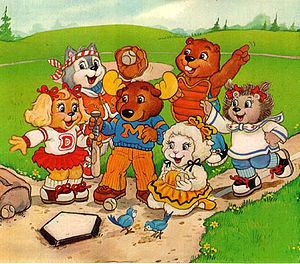
The Get Along Gang franchise was loosely inspired by Hal Roach's Our Gang series of short films. The following six members of the gang were the core members, while the other six did not make many appearances in the series, but they were regulars in merchandising and on storybooks. Sometime after the thirteen television episodes were produced, two more members were added to the gang.
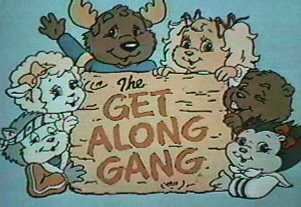
Each of the characters also has obvious faults, which they learned to overcome with the help of friends. For instance, Montgomery Moose, the group's leader, is quite clumsy; Woolma Lamb is extremely vain and self-centered; Dotty Dog could be careless; Zipper Cat could be overbearing, Portia Porcupine could get upset easily; Bingo Beaver could be greedy and tended to get himself and/or others into trouble (although he was not mean-spirited like the Gang's enemy, Catchum Crocodile).
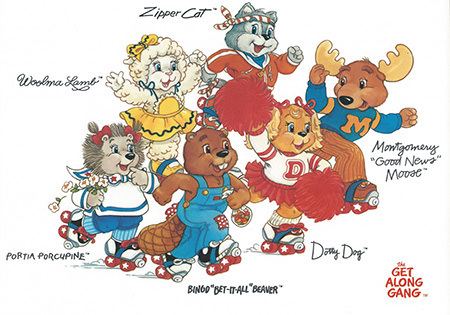
The two regular villains of the show were the only non-mammals in the series aside from Braker:
Both of their outfits suffer from recoloring or discoloring issues.
Other characters included:
TV series
Canadian studio Nelvana, in association with Scholastic Entertainment, Those Characters from Cleveland, and LBS produced a pilot episode of The Get Along Gang, which was broadcast on the Nickelodeon cable network in April 1984. The plot revolved around the twelve members of the gang as they try to win a scavenger hunt despite Catchum's cheating and their own competition-fueled infighting. Although all twelve characters were involved, only the six core gang members (Montgomery, Dotty, Zipper, Bingo, Woolma, and Portia) had speaking roles. Among the voice talents in the pilot were Charles Haid (then of Hill Street Blues) as Montgomery and Dave Thomas (fresh from his days on SCTV) as Leland. The pilot also aired in syndication nationwide during the summer of 1984. John Sebastian, famous for working for Nelvana at the time, wrote and sang for the pilot.
For reasons unknown, in between the pilot episode and the series premiere on CBS, production of the series was handed over to DIC Entertainment, a French animation studio. Thirteen half-hour episodes were produced, each containing two eleven-minute segments. As with the pilot, the focus was on the six core members of the gang, with the other six members making very sporadic appearances. Out of those six, only Braker Turtle had a regular speaking role. The show returned to CBS in reruns from January–June 1986. From September 1986 until August 1987, all thirteen DIC-produced episodes were rerun as part of a short-lived syndicated cartoon package called Kideo TV. Reruns of the series later aired on The Family Channel (now Freeform) from 1990–1993 and on the children's programming block of Pax TV (now Ion Television) from 1999–2001 the Pilot Episode of The Get Along Gang aired in the year 2000 on other syndicate channels.
Voices
Other merchandise
The brief series spawned a large range of merchandise and spin-off projects including stuffed toys and action figures made by Tomy and a series of storybooks published by Scholastic Press. The Tomy action figure line and Scholastic Press books actually lasted longer than the DiC cartoon series itself.
The characters were also adapted into comic books. In America, their series, which ran for six bi-monthly issues in 1985 and 1986, was published by Marvel Comics' Star Comics imprint. In the United Kingdom, Marvel UK published a weekly Get Along Gang comic, which ran for 93 issues from April 1985 until January 1987.
Reception and criticism
In 1986, Ralph Novak of People Weekly observed that Nelvana's pilot special "is enlivened by the music of John Sebastian and some relatively sophisticated (for television) animation. Cartoon violence is only the most innocuous sort."
The series was the product of an era in the 1980s when television watchgroups held great influence over children's programming, demanding that shows intended for young viewers emphasise positive values rather than violence or conflict. Consequently, critics of the series accused it of "enforcing" the importance of group harmony over individualism.
In an August 8, 1997 article written by television/cartoon writer Mark Evanier for his website, POVonline, in which he recalled writing for the Dungeons & Dragons cartoon series, which premiered one year before The Get Along Gang (and aired alongside it on the CBS lineup), Evanier noted:
[Television watchgroups] all seek to make kidvid more enriching and redeeming, at least by their definitions, and at the time, they had enough clout to cause the networks to yield. Consultants were brought in and we, the folks who were writing cartoons, were ordered to include certain "pro-social" morals in our shows. At the time, the dominant "pro-social" moral was as follows: The group is always right...the complainer is always wrong.
This was the message of far too many eighties' cartoon shows. If all your friends want to go get pizza and you want a burger, you should bow to the will of the majority and go get pizza with them. There was even a show for one season on CBS called The Get-Along Gang, which was dedicated unabashedly to this principle. Each week, whichever member of the gang didn't get along with the others learned the error of his or her ways....
...I don't believe you should always go along with the group. What about thinking for yourself? What about developing your own personality and viewpoint? What about doing things because you decide they're the right thing to do, not because the majority ruled and you got outvoted?
Decline and attempted revival
In mid-to-late 1985 the toy and greeting card sales began to decline, the first sign of the Gang's popularity waning. A few products (plastic figurines, some greeting cards, and a coloring book) were released, with Hocus Hare and Pocus Possum joining at the tail-end of the Gang's run. The greeting card and toy line ended in 1987, and the Scholastic book line lasted for some additional time.
In mid-2004, the Joester Loria Group, a licensing and marketing agency, announced the addition of The Get Along Gang to its stable of classic properties. Plans called for the availability of merchandise, such as clothing, toys, games and home decor; this relaunch never materialized. In 2005, American Greetings started plans for an official relaunch of the franchise, which was going to feature 5 new characters: Mogo (a moose), Reagan (a dog), Hatch (a cat), Mayfield (a lamb) and Domino (a beaver), accompanied by an elderly Portia Porcupine, now named Mrs. Bristlemore. There was even a CGI pilot in development at Richcrest Animation (an unfinished version of this pilot has been posted online). However, for unknown reasons the planned revival was shelved by late 2007, shortly after American Greetings refused to approve the original DVD release of the series.
Home entertainment releases
Karl-Lorimar released the Nelvana pilot on VHS shortly after it premiered on television in 1984. During the show's run, Kideo Video released several VHS tapes that included select episodes.
In April 2007, plans for a DVD release of the series were announced by S'More Entertainment (who released The Littles, another DIC series, to DVD); however, the planned release was announced to be cancelled a month later because American Greetings, who owns the property (and thus had the final say on the matter), would not approve it. Before the announcement of the cancellation, a representative of S'More stated that it was unlikely the release would include the pilot episode, since it involved royalty issues with Nelvana (producer of the special) and with John Sebastian (whose performing in the episode required music clearances).
On July 19, 2011, Mill Creek Entertainment released The Best of The Get Along Gang, a 1-disc set featuring 10 of the 13 half-hour episodes (20 of the 26 individual stories). The episodes not included on the set are Nose for News, Camp Get Along, School's Out, The Bullies, That's the Way the Cookie Crumbles and Snowbound Showdown. The remaining episodes were released on 2012 as bonus material of other Mill Creek's DVD releases, Camp Get Along and School's Out are included as a bonus feature on Mill Creek's DVD of Heathcliff: Season One, Volume One released in February 2012, and the other four stories were released in October 2012 as part of a 10-disc DVD compilation titled TV Toons to Go.
In other countries
While the characters' popularity was strong only in the United States, the series was released in several countries and dubbed into local languages. In Spanish, the series was translated as La Pandilla Feliz (The Happy Gang) and aired on local channels in Mexico, Costa Rica, Venezuela and Chile, but did not have the same impact or popularity of other 1980s cartoons. In Brazil the series was translated as A Nossa Turma (Our Gang) and was a modest success running on SBT during the late 1980s and early 1990s. In France, it was known as Les Amichaines. The series also aired in the United Kingdom in the late 1980s, where it was a modest success too, also generating merchandise in the country.
Nelvana
Pilot: The Adventures of the Get Along Gang (1984)
